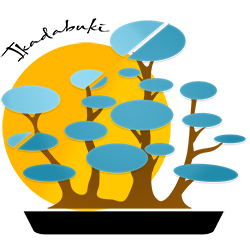Ikadabuki Style: The Raft-Style Bonsai
Definition and Origins

The Ikadabuki style, or "raft style," is a unique form of bonsai that mimics the appearance of a group of trees growing from a horizontally lying trunk. This form is often observed in nature when trees fall to the ground, their branches rising up to become individual trunks. The term "ikadabuki" refers to a floating raft, reflecting the horizontal alignment of the trunks and branches.
Distinctive Characteristics
- Horizontal Trunk: The Ikadabuki style is characterized by a main trunk lying horizontally, from which several vertical trunks emerge.
- Multiple Vertical Trunks: These vertical trunks, which were initially branches, represent individual trees. They are generally of varying sizes to create an impression of depth and naturalness.
- Visible Roots: Roots emerge from the lying trunk and penetrate into the soil, giving the impression that each vertical trunk is a separate tree.
- Dense and Balanced Foliage: The vertical trunks bear dense foliage, contributing to the illusion of a miniature forest.
- Long and Low Pot: The Ikadabuki style is often presented in an elongated pot, suited to the horizontal layout of the trunk.
Species Selection
Fast-growing and heavily branching species, such as junipers, pines, and certain types of maples, are well suited to the Ikadabuki style. These species allow for efficient formation of multiple trunks from branches.
Maintenance and Cultivation Techniques
- Pruning and Pinching: Regular pruning is necessary to maintain the shape of the vertical trunks and to encourage dense and balanced branching.
- Wiring: Wiring can be used to initially direct the branches upward, transforming them into vertical trunks.
- Repotting and Substrate: Repotting should be done carefully to not disturb the arrangement of roots and trunks. A well-draining substrate is essential.
Conclusion
The Ikadabuki style is a fascinating and creative representation in the art of bonsai, offering a miniature interpretation of a natural forest scene. This style is particularly appreciated for its ability to tell a story of survival and regeneration, symbolizing the resilience and continuity of life.

















